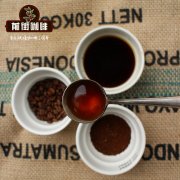Costa Rican Coffee-Costa Rican Coffee

Professional coffee knowledge exchange more coffee bean information please follow the coffee workshop (Wechat official account cafe_style)
Front Street-Costa Rican Coffee introduction
The Republic of Costa Rica (Spanish: La Rep ú blica de Costa Rica), referred to as "Costa Rica", is a presidential republic located in Latin America, bordering Nicaragua in the north and Panama in the south. It is an indispensable backbone of fine coffee in the world.
The coffee beans produced at the high latitudes of Costa Rica are also famous in the world, full-bodied and mild in taste, but the extremely sour taste makes many people unable to stop. The coffee beans here have been carefully processed, and that is why there is high-quality coffee. Located in the south of SanJos é, the capital of Tarasu, Costa Rica is one of the most valued coffee growers in the country.
All the coffee trees planted in Costa Rica are Arabica coffee trees. Through improvement, the quality of coffee beans is better and more stable. In order to facilitate picking, regular management is carried out. The coffee tree is kept at a height of about 2 meters by pruning at different times; the coffee that people eat is the taste of the seeds in the fruit that are brewed in water.
After picking raw coffee beans, you must remove the peel, pulp, seed film and sun exposure before the seeds (that is, coffee beans) can be roasted. Part of the process can be replaced by machines, and the speed of coffee production increases a lot. However, there is no machine to do coffee picking, so you must use manual labor.
Costa Rican coffee has full particles, ideal acidity and unique strong flavor. Costa Rica's coffee industry, originally controlled by the Costa Rican Coffee Industry Company (ICAFE), has been taken over by the official Coffee Committee (Oficinale Cafe). Among the exported coffee, those products that are considered to be of substandard quality are colored with blue vegetable dyes and then transferred back to China for sale. Coffee consumed domestically (dyed blue or undyed) accounts for about 10% of total production, and local per capita coffee consumption is twice that of Italy or the United States.
In short: Qianjie is a coffee research hall, happy to share the knowledge about coffee with you, we share unreservedly just to make more friends fall in love with coffee, and there will be three low-discount coffee activities every month. The reason is that Qianjie wants to make more friends drink the best coffee at the lowest price, which has been Qianjie's tenet for 6 years!
END
Important Notice :
前街咖啡 FrontStreet Coffee has moved to new addredd:
FrontStreet Coffee Address: 315,Donghua East Road,GuangZhou
Tel:020 38364473
- Prev

Where are the chocolate-flavored coffee beans? Colombia coffee tastes like chocolate.
Professional coffee knowledge exchange More coffee bean information Please pay attention to Coffee Workshop (Weixin Official Accounts cafe_style) Front Street-Introduction to Cauca Production Area of Colombia Cauca department belongs to the production area certified by Colombia coffee origin, located in the southwest of Colombia, adjacent to Narino Department and Huila Department
- Next

How much is Blue Mountain Coffee?
Professional Coffee Knowledge Exchange More Coffee Bean Information Please Pay Attention to Coffee Workshop (Weixin Official Accounts cafe_style) Front Street-Blue Mountain Coffee Introduction The famous Jamaica Blue Mountain Coffee has three grades, namely: Jamaica Blue Mountain Coffee, Jamaica High Mountain Supreme Coffee Beans and Tooth Buy
Related
- Beginners will see the "Coffee pull flower" guide!
- What is the difference between ice blog purified milk and ordinary milk coffee?
- Why is the Philippines the largest producer of crops in Liberia?
- For coffee extraction, should the fine powder be retained?
- How does extracted espresso fill pressed powder? How much strength does it take to press the powder?
- How to make jasmine cold extract coffee? Is the jasmine + latte good?
- Will this little toy really make the coffee taste better? How does Lily Drip affect coffee extraction?
- Will the action of slapping the filter cup also affect coffee extraction?
- What's the difference between powder-to-water ratio and powder-to-liquid ratio?
- What is the Ethiopian local species? What does it have to do with Heirloom native species?

